Most AP Racing Brake Discs feature Curved Vanes. The brake discs are handed and should be installed with the cooling vanes running back, from the inside to outside diameters in the direction of rotation as indicated in the sketch below.

All cast iron brake discs for competition use need to be bedded-in to ensure heat stabilisation and improve resistance to cracking. Cracks or even disc failure can occur during the first few heavy stops if careful bedding is not carried out.
AP Racing recommend the following procedure:
- If ducts are fitted they should be ¾ blanked off.
- Use previously bedded pads.
- For a minimum of 15 Km use brakes gently at first from initially low speeds - progressively raise speed to normal racing speed but still using gentle applications.
- For the final 2 or 3 applications brakes can be used quite heavily.
If AP Racing thermal paints are used then only the Green paint (430°C) should have fully turned to white and maybe also just the Orange paint (560°C) on the outside edges of the discs during the bedding procedure.